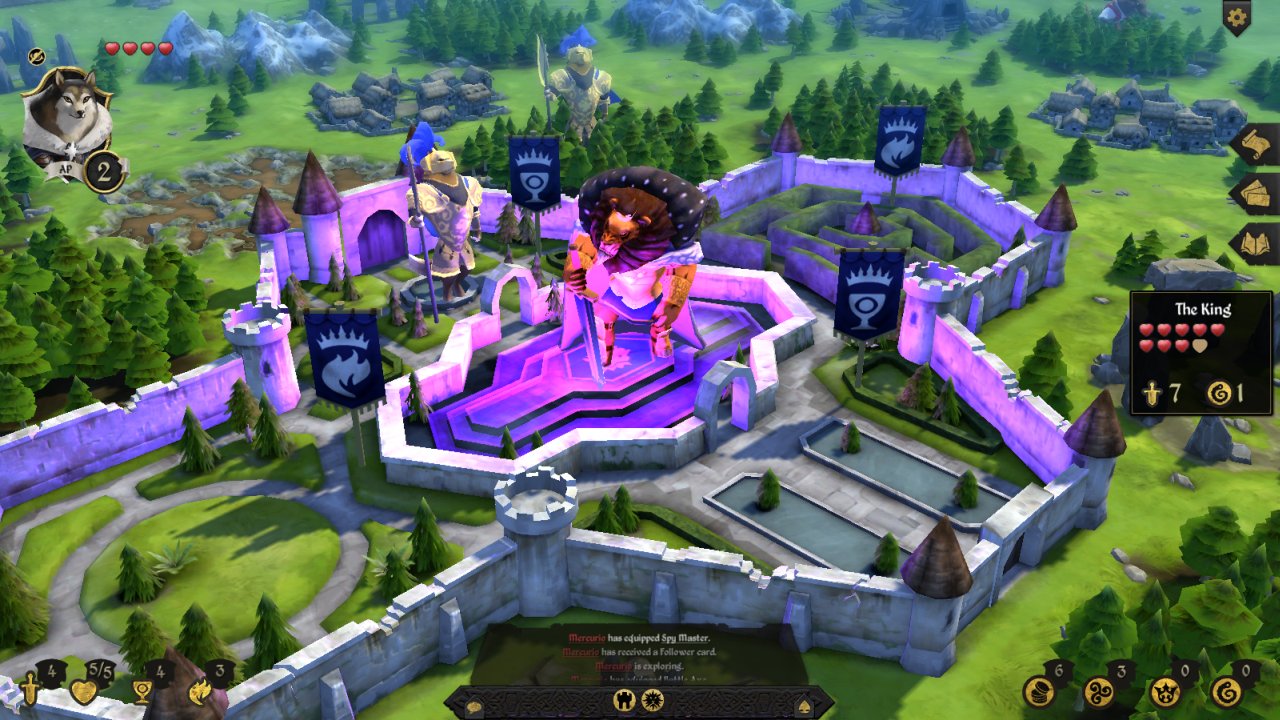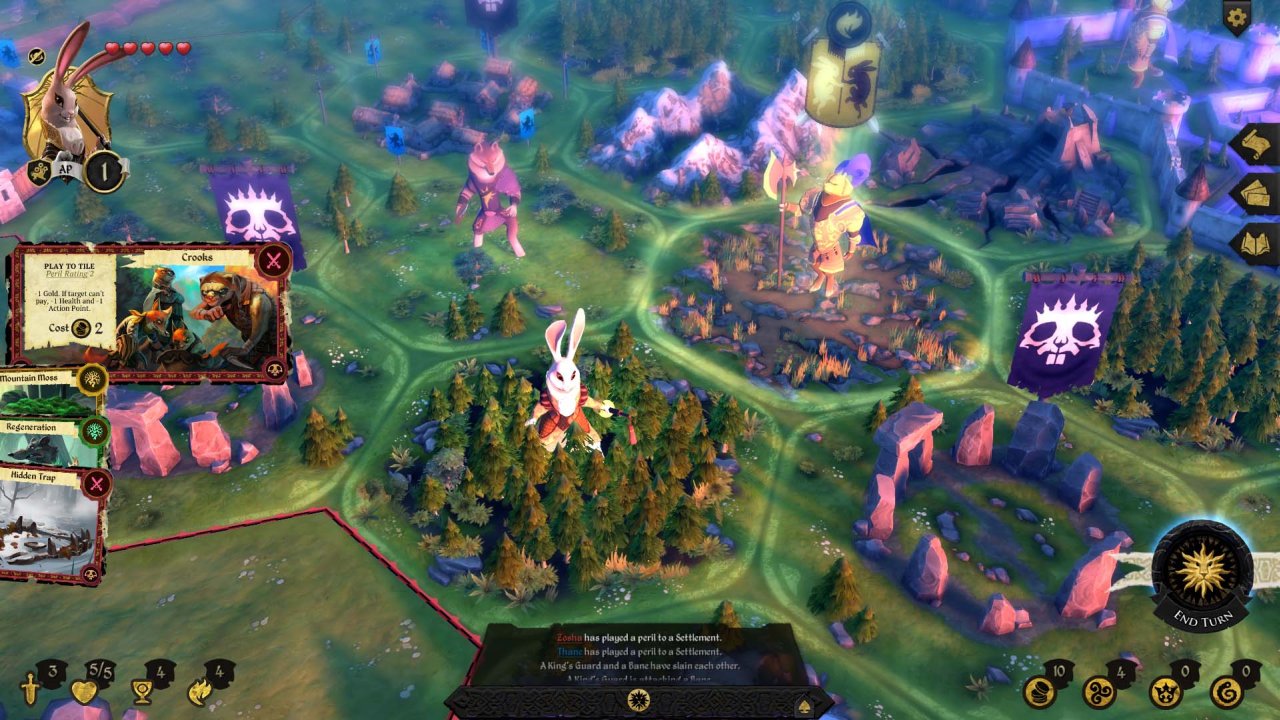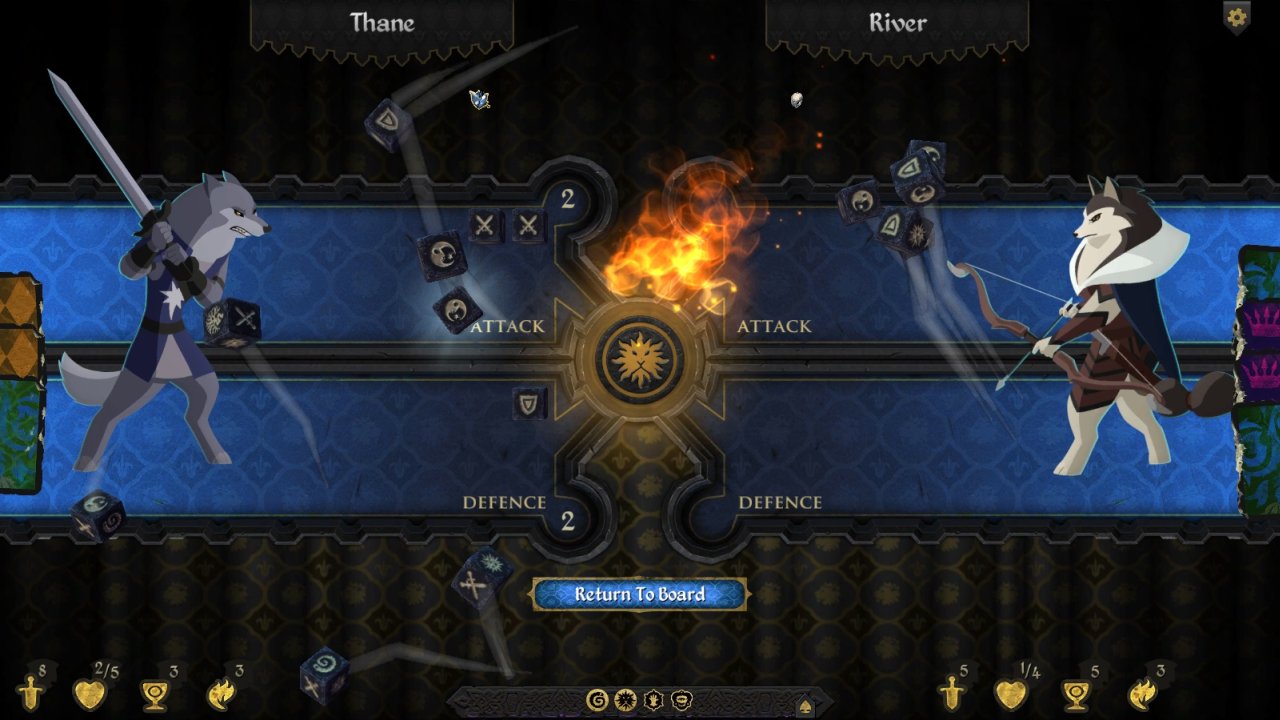Armello Review
Finally, time to sink your claws into some deep stat-based boardgaming
At some point when I was first introduced to Armello, somebody said the phrase “Redwall meets Game of Thrones”, and I immediately knew that I would be playing it. In my humble opinion, the gaming industry is lacking in anthropomorphized animal adventure (and alliteration!), and any game that gives me the chance to play as a halberd-wielding otter has already earned points in my book. The fun bit Armello is that it not only lets you play as that otter, you can also play as a cutesy little bunny rabbit who takes over the kingdom by letting their soul rot away and stabbing the king with your parasol. But I’m getting ahead of myself.

Armello is a digital board game in which four characters each vie for the throne of a fantasy animal kingdom. The situation is an intriguing one, from the perspective of both story and gameplay. The king lion of Armello is sick, mad, and dying. It is inevitable that within nine days (eighteen turns), he will die without an heir, leaving the kingdom to a new ruler. The tricky point is that who this new ruler will be is quite changeable. The king may be defeated in single combat (in which case his vanquisher earns the crown), but he may also be banished by any hero who holds four ‘spirit stones’. He could also die naturally of his illness, in which case the most famous hero (represented by a player having ‘prestige’ points) becomes the new monarch by the will of the people. This split of win conditions is a central feature of the game: much of your strategy will come down to deciding which approach to kingmaking gives you the best chance of taking the throne, and oftentimes you will start off chasing one condition, only to switch halfway through the game to another.
The great part about this design is that by the final few rounds, players have mostly committed to opposing strategies that naturally check each other. For example, the player with the most prestige points has an interest in protecting the king (whose palace sits at the center of the board), while a player who has focused on either combat or stone-gathering wants to sneak into the king’s palace without a fight. In the middle stages of the game, a ‘top dog’ player (or more fittingly, ‘top wolf’) can usually be stopped by having all three opponents delay or damage him, but with each round, every player gets closer to their win condition. Tension in the game naturally ramps up, until you are often holding your breath turn-by-turn to see whether each player can just barely achieve their goal and end the game. Gameplay takes place on a hex-grid board with differing tile-types that will bring back fond memories of Settlers of Catan (more on this comparison later). With each turn, a player may move their character three spaces, chasing after quest objectives which grant loot and level your character, conquering settlements that grant gold, or engaging in combat (to brush that pesky rat-thief out of the way).
The aesthetic of Armello is polished to a fine sheen, perfectly capturing a colorful, adventurous tone. It’s to a game’s credit that you’ll be just as pleased to play a rabbit as a wolf: excellent animation and truly standout card artwork that rivals the best that triple-A titles can afford. The music doesn’t particularly stand out, and although sometimes the soundscape feels a touch uneven, with certain alerts popping out intrusively, for the most part it paints a rich kingdom on your hex board. The biggest complaint against the aesthetic is a compliment-in-disguise: there’s too little of it. If you’ve seen the trailer for Armello, you’ve seen the only cutscene in the game, and even the four-part prologue simply isn’t enough to truly flesh out a story. Armello instead relies on its depth of gameplay.

…and what depth! The game is complex enough that it could easily scare off beginners, and there are so many mechanics to be understood that the four-part prologue tutorial can only run them by the player in quick succession. Day-night cycles, spells and counter-spells, the afore-mentioned win conditions, special abilities, static effects, combat tricks… the list is too long to approach in any depth in this. It is definitely ideal to stick with a single favorite character at first (I would suggest Amber the Rabbit or River the Wolf), and while you’re at it, a bot-game or two wouldn’t be a bad idea. Even with the high learning curve, the depth of the game ends up being an overall strong benefit, for two key reasons. Firstly, it allows for a wonderful variety of playstyles, and secondly, it offers players a multitude of ways to influence the RNG gods of the game. Armello hits that sweet spot where when you win, you can always feel like your brilliant strategy was the cause, but if you lose, you can pat yourself on the back and claim that it all came down to that one bad dice roll on turn five. Dice-based combat means that the player with the lower stat will come out on top, but there are so many ways to add dice, add attacks, or force certain die outcomes that you never really feel like the game is outside your control.
But depth of gameplay simply isn’t exciting without balance, and the good news is that Armello has even more balancing mechanics than it has cute whiskered animal races. You could focus all your upgrades on combat… but then you’ll be vulnerable to player traps (which test a different stat). You could ignore combat to emphasize trickery and maneuverability instead, but then a wandering monster may kill you and send you all the way to your starting square. You can burn your cards in battle to guarantee a strong attack, or maybe it would be better to save them for later actions.
Possibly the most fascinating balancing mechanic is the concept of Rot. Your Rot stat is a measure of how infected your character has become (with your standard gloomy fantasy ‘Eeeeevil’!). It is usually to be avoided: players with any Rot points occasionally take extra damage, and are often disadvantaged in battle. But then comes the kicker: in any combat, if both players have a Rot score, the player with the most Rot gains all of his opponent’s Rot score as extra dice in attacks. That means that whenever you fight an opponent, you either want to have no Rot at all, or just a little bit more than them. The result is that a player starts out incentivized to have no Rot at all, but as the game continues, they may change their mind and instead deliberately grant themselves as much Rot as possible, allowing them to play powerful cards and turn into a nigh-unstoppable juggernaut. The result is that in most games, one player will eventually, well, give in to the madness, and attempt to take over the game by becoming so infested that even the rotting King himself must give up all his Rot in combat. Rot is an excellent example of story and gameplay intertwining: it may be that the hero can only defeat a monster by becoming a monster himself.
From a gameplay perspective, Armello’s greatest flaw is built deep into the core of its entire design: the game is turn based, and requires four people. Two-player turn based games are difficult enough to keep relevant in the online gaming world, but with a strict four-player setting, the player spends thrice the amount of time watching other players as taking their own turn. This single downside is the biggest hurdle for the game to overcome, and to its credit it does make several efforts to ease the ‘waiting itch’. Some player actions can be taken during an opponent’s turn, like selecting a new quest, or playing a few cards from your hand. Turns do have a time limit, to help prod that one player into speeding up, and there’s a wide selection of verbalizations (sadly only in text form) for reacting to player’s moves.

But even with these attempts to keep the down-time interesting, there are too many aspects that can drag it into dreariness. The menu of verbalizations can’t compete with your standard real-life board game ability to chat with other players at the table, giving advice or reacting. A voice-chat, or even simple text-based chatting, is sorely needed in Armello. The game has a habit of showing every NPC move, even if it doesn’t affect any player, and although these have been trimmed to only a few seconds, the occasional pause while the NPC ‘thinks’ is surprisingly infuriating. The ability to view your opponent’s battles as they occur is entertaining (mainly so you can gleefully see them killed off by one missed dice), but by necessity, much of a player’s turn still bores others.
All this waiting for other people naturally makes players tempted to tab away from the game, but in a classic example of how a tiny aesthetic detail can make a big difference, Armello has no audio cue to let you know when your turn is beginning. People who tab away will either need to constantly tab back to see whether it’s their turn yet, or will occasionally miss their turn start, drawing out the game and making the wait even more infuriating for other players.
If these wait-times are a deal-breaker for you, then there’s not much that Armello can do to make it up. That said, all the other strong aspects of Armello definitely warrant it a recommendation. It has too many of those aspects that gamers praise: excellent depth, with clear balancing, a variety of playstyles, and a polished, colorful aesthetic. It’s definitely worth the asking price, and if you have a known sweet-spot for hex-grids and furry animals with swords, it might just become a favorite.
 Comments
Comments











